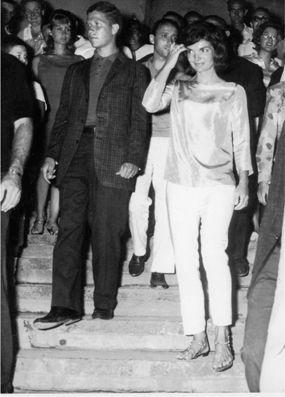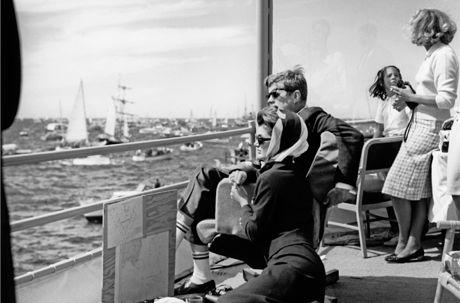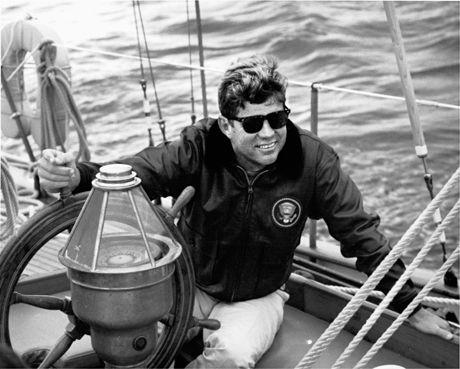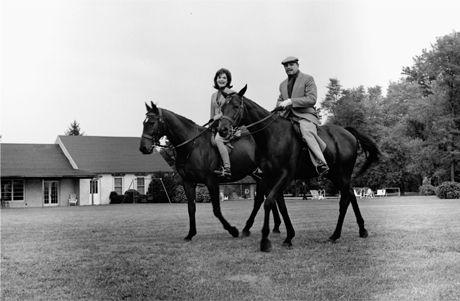Mrs. Kennedy and Me: An Intimate Memoir (32 page)
Read Mrs. Kennedy and Me: An Intimate Memoir Online
Authors: Clint Hill,Lisa McCubbin
Tags: #General, #United States, #Political, #Biography, #History, #Non-Fiction, #Politics, #Biography & Autobiography, #United States - Officials and Employees, #20th century, #Presidents & Heads of State, #Onassis; Jacqueline Kennedy - Friends and Associates, #Hill; Clint, #Presidents' Spouses - Protection - United States, #Presidents' Spouses


Paul Landis escorts Mrs. Kennedy in Positano
A
S THE DAYS
went by, everybody fell more in love with Ravello. It was so picturesque, so charming, the people so warm and friendly. Finally, on August 31, we bid farewell to Italy. The three weeks on the Amalfi coast had been nothing less than enchanting, and all of us, especially Mrs. Kennedy, were sad to leave. When I think back and remember those special times, one of the things that stands out is the memory of the view in the evening, looking down the coastline. Anchored in the harbor at Amalfi, a thousand feet below Ravello, the fishing boats and private yachts were decorated with strands of tiny white lights throughout the rigging, so that it looked like a hundred thousand candles dancing in the water. It was magical.
October Crisis

A
fter a month in Hyannis Port and three weeks in Italy, I assumed we would return to Washington, but we ended up flying straight from Rome to New York to Quonset Point, Rhode Island, where the president met us, along with an enormous crowd and full press coverage. It was a wonderful, happy family reunion, and from there we were off to Hammersmith Farm for the next several weeks.
While Mrs. Kennedy typically spent September weekends at Hammersmith Farm, the president was particularly interested in being there in September 1962 because the America’s Cup yacht races were being held off the coast of Newport in Narragansett Bay. The America’s Cup is the oldest active trophy
in international sport, a series of races between the defender—the yacht club that last won the title—and the challenger. This year, America’s team from the New York Yacht Club was defending its title against Australia—the first time the challenger was from a country other than Great Britain or Canada. There were plenty of social events surrounding the races, including a reception for crew members at Hammersmith Farm and a black-tie dinner in honor of the Australian and American competitors, which created plenty of work for the Secret Service.
After spending so much time on the
Agneta,
Mrs. Kennedy appeared to take a real interest in the races, which seemed to please the president. It was an entirely new sport for me to watch and I found it interesting—especially the days we were aboard the USS
Joseph P. Kennedy, Jr.
, a U.S. Navy destroyer named after the president’s older brother, who was killed during World War II. Some of the races were very close, and in the end the New York Yacht Club’s
Weatherly
defeated Australia’s
Gretel
4–1 in the best-of-seven race series.

Clint Hill’s favorite photo of JFK at the helm of the
Manitou
Also around this time, a new yacht joined the mix of boats the president had at his disposal. The USS
Manitou
was a beautiful sixty-two-foot yawl, a
Coast Guard vessel, brought to Newport as an addition to the presidential fleet specifically because of the president’s love of the sea and sailing. The president was excited about the opportunity to have a large sailing yacht available, and the
Manitou
had everything he wanted. She was sleek, fast, and maneuverable, and capable of taking overnight trips with sleeping accommodations for nine people.
The last two weeks of September were a blur as we traveled between Newport and Hyannis Port—to visit the president’s father and so the president and Mrs. Kennedy could vote for Teddy Kennedy in his first senatorial primary—and then back to Newport, followed by a one-night stop in New York City, where I accompanied Mrs. Kennedy to the brand-new Philharmonic Hall for a performance of the New York Philharmonic Orchestra, led by Leonard Bernstein, then back to Newport again for the finish of the America’s Cup races. While the president returned to Washington during the weekdays, Mrs. Kennedy intended to stay at Hammersmith Farm with the children until October 9, 1962. We did have a brief return to Washington—to Middleburg, actually—because President Ayub Khan of Pakistan happened to be visiting the United States.

Mrs. Kennedy and Ayub Khan riding together at Glen Ora
Mrs. Kennedy was eager to show Ayub Khan how delighted she was with Sardar, and she insisted on him coming to Glen Ora, so that they could ride
together. There was nothing romantic between Mrs. Kennedy and Ayub Khan but their mutual love of horses was the bond they shared, and Sardar was the emblem of that bond. President Kennedy also realized that the first lady’s trip to India and Pakistan earlier in the year had been immensely successful in the Cold War campaign to promote the interests and ideology of the United States around the world.
The long summer and early fall away from Washington was about to come to an end, and I must admit I was a little bit sad about it. I thoroughly enjoyed being “on the road” where there was no routine, and while at times it was more challenging to protect Mrs. Kennedy, I thrived on the constant activity. The time spent in Hyannis Port, Ravello, Amalfi, Capri, New York City, and Newport had been wonderful. And because I had shared all these adventures with Mrs. Kennedy, she and I were closer than ever before. We enjoyed each other’s company, I knew how she liked to have things done, and we trusted each other implicitly.
Finally, on October 9, 1962, we were headed back to the White House. The
Caroline
was unavailable, so Mrs. Kennedy, Caroline, John, and I, along with the Kiddie Detail agents and several staff members, boarded a U.S. Air Force plane and flew to National Airport in Washington, D.C.
At one point during the flight Mrs. Kennedy came to me and asked, “Mr. Hill, will there be any press at the airport when we arrive in Washington?”
“I honestly don’t know, Mrs. Kennedy,” I said, “but let me see what I can find out about the situation before we land.”
“I really do not want any photos taken.”
I understood her concern because this would be the first time in more than three months that she and the two children would be seen in public together. In all likelihood there would be a swarm of photographers waiting to get the shot of the three of them getting off the plane. It was also somewhat unusual for us to be flying on a military aircraft without the president aboard, and I certainly didn’t want that to stir up any controversy, either.
“Okay. I understand. I’ll make the appropriate arrangements.”
I contacted the U.S. Secret Service office at the White House and requested a restricted area be established for our arrival. Secret Service personnel would be there with a car for Mrs. Kennedy and the children, White House cars for staff, and a baggage truck. When we landed, the pilot taxied the plane to the spot we had agreed on, and I could see that all the necessary vehicles were standing by,
just as I had arranged, behind a gate waiting for the all-clear to proceed toward the plane.
I was standing behind Mrs. Kennedy as she began going down the steps to the tarmac, with Caroline and John in front of her, when I noticed a motorcycle following our vehicles through the gate and toward the plane. There were two people on the motorcycle—a courier driving and a photographer I recognized, holding his camera up and shooting one shot after another.
Goddamnit.
This particular photographer had been overly aggressive and intrusive in the past, and I had had it with him.
As I got to the bottom of the steps, I ran toward him, grabbed hold of him, pulled the camera out of his hands, and ripped the film out of the camera.
“What the hell are you doing?!” he screamed at me.
“You’re in a restricted area and I’m confiscating your film,” I said.
I saw two more canisters of film in his chest pocket, and without saying anything, I grabbed those and shoved them in my own jacket pocket.
He was really putting up a fuss and by this time the airport police had come over.
“He’s all yours,” I said.
By this time Mrs. Kennedy, John, and Caroline were in the car, so I took my place in the front passenger seat. I turned around and said, “Sorry about that, Mrs. Kennedy. That was Roddy Mims from UPI. We’ve had trouble with him in the past.”
I pulled out the canisters of film from my pocket and showed them to her. “But I got the film, which, as you could tell, he wasn’t happy about.”
She smiled and said, “Well I’m happy about it. Thank you so much, Mr. Hill. I really appreciate the fact that you went after him.”
I hated that the children had to see that confrontation, but it didn’t seem to faze them. The matter was forgotten, as Caroline chattered away to her mother on the ride back to the White House.
Shortly after arriving at the White House, I was notified that the president wanted to see me in the Oval Office
immediately.
Geez. Word travels fast.
When I walked into the Oval Office, President Kennedy and Press Secretary Pierre Salinger were standing there, waiting for me.
The president had his arms folded and got right to the point.
“What happened at National Airport, Clint?” he asked.
I explained Mrs. Kennedy’s concerns, and what I had done to arrange a private arrival.
“Then, Mr. President, photographer Roddy Mims came riding into the area we had restricted, on the back of a motorcycle driven by a courier. I stopped him, confiscated his film, and turned him over to the airport police.”
